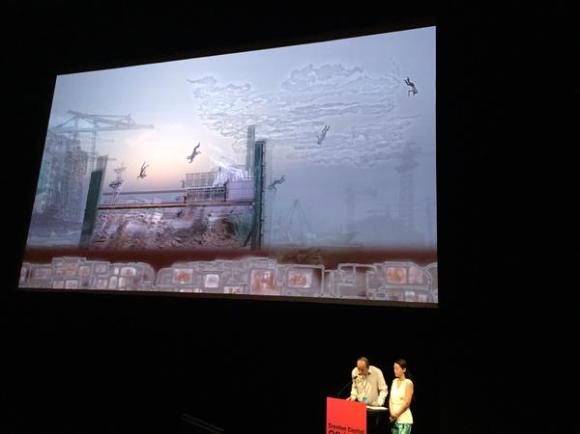
Representing the art studio, Lily & Honglei presented on-going project “Shadow Play: Tales of Urbanization of China” during a week long gathering of art professionals and Creative Capital grantees in both 2015 and 2013, who have received support from the organization for their projects in four categories: Moving Image, Visual Arts, Emerging Field and Performance Arts.
“We’re deeply moved by these artists’ courageous works that are pushing the boundaries, advocating for social justice, or promoting community wellbeing.” Lily and Honglei stated, “it was a great honor and wonderful opportunity to share our work with a group of exceptional artists. Through our project, we wanted to make a voice for those who cannot.”

A transcript of Lily & Honglei’s presentation:
Our project is called “Shadow Play: Tales of Urbanization of China.” We are building the piece on both deep research and our 30-year life experience in China. The intention of this multimedia project is to visualize the urbanization process that has irreversibly changed the society, culture, and environment of the world’s most populous country.
Visually, the project is inspired by traditional Chinese shadow play, while technologically it’s decidedly forward-looking: first, we are developing digital animations for video installation in physical space; second, virtual reality sets the foundation for another facet of the piece- much of the project could be experienced through an immersive environment in cyperspace that anybody with Internet connection could access in real-time. A third segment of the piece will be developed using augmented reality technology on mobile devices. The three layers combine into a visual account of the complex process of urbanization, highlighting the tragic story of one Chinese rural family. The work is presented in four chapters:
The First Chapter shows the family of the village head leading a peaceful live in the countryside. It presents a landscape with traditional residences built in harmony with the natural environment. This chapter also depicts the violent confrontations between the villagers and a demolition team working for the local government and real estate developers. This type of clashes, often deadly, has become commonplace as a result of large-scale land-grabbing over the past two decades. At the end of this chapter, the village head is brutally crushed to death by the demolition team’s truck.
In Chapter 2, the village is demolished and most parts reduced to rubble. The rural landscape has been drastically transformed. The child of the village head is alone playing outside one night when a stranger in dark suit emerges and gives the child candy. Subsequently, the child is drugged and abducted. This chapter addresses the serious social problem of child abduction. It’s estimated that some 70,000 children are kidnapped in China every year, with many of them sold for adoption. The one-child policy, a fundamental strategy for China’s economic growth, has contributed to this problem.
In Chapter 3, the mother begins her journey looking for the missing child. She arrives the city’s train station along with countless migrant workers who are later struggling with their urban lives. Many of them have to live in the ‘underground city,’ which is an enormous network that comprises of tunnels, basements, even bomb shelters. This complex is located underneath the skyscrapers that they built with their own hands. The imagery of the falling workers is a metaphor for their fate. This specifically reflects on the worker suicide cases at the Foxconn factory, the electronics manufacturer behind popular products like the iPad and the iPhone.
In the last chapter, the mother continues to travel across the country in search of her child. Through her journey she observes the environmental degradation. Water and soil are severely polluted by industrial waste. Both rural and urban areas are shrouded in smog. All of such is caused by the mindless exploitation of the environment for the sake of fast economic growth. Meanwhile, the cultural heritage verges on extinction. Countless historic sites have submerged underwater as a result of gigantic engineering projects. The social environment remains as repressive as ever: the whole system can be compared to a maze without an exit, with people trapped within.
One day, the mother finds herself facing a heartbreaking sight: 5 homeless boys are found dead in a garbage container. They died from carbon monoxide poisoning after attempting to warm themselves by burning charcoal inside. In fact the five kids are among the 60 million Chinese children who left behind in the countryside when their parents set off as migrant workers.
We will also share a few clips of our previous work. Our proposed project “Shadow Play” will be completed around the summer of 2016. we are seeking some opportunities, particularly exhibition venues such as museums, galleries or art festivals. Also, we hope to develop collaborations with our fellow artists. This is our project. Thank you very much!
Visit Creative Capital blog for more info:
http://blog.creative-capital.org/2015/07/the-2015-creative-capital-artist-retreat-begins/
and on Instagram: https://instagram.com/explore/tags/ccretreat/

